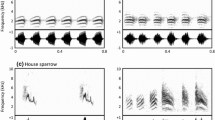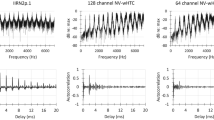Abstract
Physical tradeoffs may in some cases constrain the evolution of sensory systems. The peripheral auditory system, for example, performs a spectral decomposition of sound that should result in a tradeoff between frequency resolution and temporal resolution. We assessed temporal resolution in three songbird species using auditory brainstem responses to paired click stimuli. Temporal resolution was greater in house sparrows (Passer domesticus) than Carolina chickadees (Poecile carolinensis) and white-breasted nuthatches (Sitta carolinensis), as predicted based on previous observations of broader auditory filters (lower frequency resolution) in house sparrows. Furthermore, within chickadees, individuals with broader auditory filters had greater temporal resolution. In contrast to predictions however, temporal resolution was similar between chickadees and nuthatches despite broader auditory filters in chickadees. These results and the results of a model simulation exploring the effect of broadened auditory filter bandwidth on temporal resolution in the auditory periphery strongly suggest that frequency resolution constrains temporal resolution in songbirds. Furthermore, our results suggest that songbirds have greater temporal resolution than some mammals, in agreement with recent behavioral studies. Species differences in temporal resolution may reflect adaptations for efficient processing of species-specific vocalizations, while individual differences within species may reflect experience-based developmental plasticity or hormonal effects.






Similar content being viewed by others
Abbreviations
- ABR:
-
Auditory brainstem response
- AEP:
-
Auditory evoked potential
- CAP:
-
Compound action potential
- ERB:
-
Equivalent rectangular bandwidth
- PSTH:
-
Peri-stimulus time histogram
References
Brittan-Powell EF, Dooling RJ, Gleich O (2002) Auditory brainstem responses in adult budgerigars (Melopsittacus undulatus). J Acoust Soc Am 112:999–1008
Bruce IC, Sachs MB, Young ED (2003) An auditory-periphery model of the effects of acoustic trauma on auditory nerve responses. J Acoust Soc Am 113:369–388
Caras ML, Brenowitz E, Rubel EW (2010) Peripheral auditory processing changes seasonally in Gambel’s white-crowned sparrow. J Comp Physiol A Neuroethol Sens Neural Behav Physiol 196:581–599
Collin SP, Davies WL, Hart NS, Hunt DM (2009) The evolution of early vertebrate photoreceptors. Philos Trans R Soc Lond B Biol Sci 364:2925–2940
de Boer E (1996) Mechanics of the cochlea: modeling efforts. In: Dallos P, Popper AN, Fay RR (eds) The cochlea. Springer, New York, pp 258–317
Dmitrieva LP, Gottlieb G (1994) Influence of auditory experience on the development of brain-stem auditory evoked potentials in mallard duck embryos and hatchlings. Behav Neural Biol 61:19–28
Dooling RJ, Leek MR, Gleich O, Dent ML (2002) Auditory temporal resolution in birds: discrimination of harmonic complexes. J Acoust Soc Am 112:748–759
Eggermont JJ, Spoor A (1973) Masking of action potentials in the guinea pig cochlea, its relation to adaptation. Audiology 12:221–241
Feng AS, Narins PM, Xu C, Lin W, Yu Z, Qiu Q, Xu Z, Shen J (2006) Ultrasonic communication in frogs. Nature 440:333–336
Fullard JH, ter Hofstede HM, Ratcliffe JM, Pollack GS, Brigidi GS, Tinghitella RM, Zuk M (2010) Release from bats: genetic distance and sensoribehavioural regression in the Pacific field cricket, Teleogryllus oceanicus. Naturwissenschaften 97:53–61
Gall MD, Lucas JR (2010) Sex differences in auditory filters of brown-headed cowbirds. J Comp Physiol A Neuroethol Sens Neural Behav Physiol 196:559–567
Hall JW (2007) New handbook of auditory evoked responses. Pearson Education, Boston
Henry KS, Lucas JR (2008) Coevolution of auditory sensitivity and temporal resolution with acoustic signal space in three songbirds. Anim Behav 76:1659–1671
Henry KS, Lucas JR (2009) Vocally correlated seasonal auditory variation in the house sparrow (Passer domesticus). J Exp Biol 212:3817–3822
Henry KS, Lucas JR (2010a) Habitat-related differences in the frequency selectivity of auditory filters in songbirds. Funct Ecol 24:614–624
Henry KS, Lucas JR (2010b) Auditory sensitivity and the frequency selectivity of auditory filters in the Carolina chickadee (Poecile carolinensis). Anim Behav 80:497–507
Joris PX, Schreiner CE, Rees A (2004) Neural processing of amplitude-modulated sounds. Physiol Rev 84:541–577
Klump GM, Gleich O (1991) Gap detection in the European starling (Sturnus vulgaris). III. Processing in the peripheral auditory system. J Comp Physiol A 168:469–476
Konishi M (1973) How owl tracks its prey. Am Sci 61:414–424
Krishnan A, Gandour JT, Bidelman GM (2010) The effects of tone language experience on pitch processing in the brainstem. J Neurolinguistics 23:81–95
Lohr B, Nowicki S, Weisman R (1991) Pitch production in Carolina chickadee songs. Condor 93:197–199
Lohr B, Dooling RJ, Bartone S (2006) The discrimination of temporal fine structure in call-like harmonic sounds by birds. J Comp Psychol 120:239–251
Lowther PE, Cink CL (2006) House sparrow (Passer domesticus). In: Poole A (ed) The birds of North America online. Cornell Lab of Ornithology, Ithaca
Lucas JR, Freeberg TM (2007) Information and the chick-a-dee call: communicating with a complex vocal system. In: Otter K (ed) Ecology and behavior of chickadees and titmice. Oxford University Press, Oxford, pp 199–213
Lucas JR, Freeberg TM, Krishnan A, Long GR (2002) A comparative study of avian auditory brainstem responses: correlations with phylogeny and vocal complexity, and seasonal effects. J Comp Physiol A Neuroethol Sens Neural Behav Physiol 188:981–992
Lucas JR, Freebeg TM, Egbert J, Schwabl H (2006) Fecal corticosterone, body mass, and caching rates of Carolina chickadees (Poecile carolinensis) from disturbed and undisturbed sites. Horm Behav 49:634–643
Lucas JR, Freeberg TM, Long GR, Krishnan A (2007) Seasonal variation in avian auditory evoked responses to tones: a comparative analysis of Carolina chickadees, tufted titmice, and white-breasted nuthatches. J Comp Physiol A Neuroethol Sens Neural Behav Physiol 192:201–215
Marean GC, Burt JM, Beecher MD, Rubel EW (1998) Auditory perception following hair cell regeneration in European starling (Sturnus vulgaris): frequency and temporal resolution. J Acoust Soc Am 103:3567–3580
Moore BCJ (1993) Frequency analysis and pitch perception. In: Yost WA, Popper AN, Fay RR (eds) Human psychophysics. Springer, New York, pp 58–89
Musacchia G, Sams M, Skoe E, Kraus N (2007) Musicians have enhanced subcortical auditory and audiovisual processing of speech and music. Proc Natl Acad Sci USA 104:15894–15898
Noirot IC, Adler HJ, Cornil CA, Harada N, Dooling RJ, Balthazart J, Ball GF (2009) Presence of aromatase and estrogen receptor alpha in the inner ear of zebra finches. Hear Res 252:49–55
Ohashi T, Ochi K, Nishino H, Kenmochi M, Yoshida K (2005) Recovery of human compound action potential using a paired-click to stimulus paradigm. Hear Res 203:192–200
Okanoya K, Dooling RJ (1990) Minimum detectable gap in noise as a function of intensity and frequency for two avian species, budgerigars (Melopsittacus undulates) and zebra finches (Poephila guttata). Hear Res 50:185–192
Parham K, Zhao HB, Kim DO (1996) Responses of auditory nerve fibers of the unanesthetized decerebrate cat to click pairs as simulated echoes. J Neurophysiol 76:17–29
Phillmore LS, Sturdy CB, Weisman RG (2003) Does reduced social contact affect discrimination of distance cues and individual vocalizations? Anim Behav 65:911–922
Ritchison G (1983) Vocalizations of the white-breasted nuthatch. Wilson Bull 95:440–451
Supin AY, Popov VV (1995) Temporal resolution in the dolphin’s auditory system revealed by double-click evoked potential study. J Acoust Soc Am 97:2586–2593
Viemeister NF, Plack CJ (1993) Time analysis. In: Yost WA, Popper AN, Fay RR (eds) Human psychophysics. Springer, New York, pp 116–154
Wadhwa S, Anand P, Bhowmick D (1999) Quantitative study of plasticity in the auditory nuclei of chick under conditions of prenatal sound attenuation and overstimulation with species specific and musical stimuli. Int J Dev Neurosci 17:239–253
Walton JP, Barsz K, Wilson WW (2008) Sensorineural hearing loss and neural correlates of temporal acuity in the inferior colliculus of the C57BL/6 mouse. J Assoc Res Otolaryngol 9:90–101
Wysocki LE, Ladich F (2002) Can fishes resolve temporal characteristics of sounds? New insights using auditory brainstem responses. Hear Res 169:36–46
Zilany MSA, Bruce IC (2006) Modeling auditory-nerve responses for high sound pressure levels in the normal and impaired auditory periphery. J Acoust Soc Am 120:1446–1466
Zilany MSA, Bruce IC (2007) Representation of the vowel (epsilon) in normal and impaired auditory nerve fibers: model predictions of responses in cats. J Acoust Soc Am 122:402–417
Zilany MSA, Carney LH (2010) Power-law dynamics in an auditory-nerve model can account for neural adaptation to sound-level statistics. J Neurosci 30:10380–10390
Zilany MSA, Bruce IC, Nelson PC, Carney LH (2009) A phenomenological model of the synapse between the inner hair cell and auditory nerve: long-term adaptation with power-law dynamics. J Acoust Soc Am 126:2390–2412
Acknowledgments
Animal protocols were approved by the Purdue Animal Care and Use committee (# 05–058). K. S. Henry was supported by a research grant from Purdue University and the A. A. Lindsey Graduate Fellowship in Ecology. We thank R. Krishnan for the use of his auditory test equipment.
Author information
Authors and Affiliations
Corresponding author
Rights and permissions
About this article
Cite this article
Henry, K.S., Gall, M.D., Bidelman, G.M. et al. Songbirds tradeoff auditory frequency resolution and temporal resolution. J Comp Physiol A 197, 351–359 (2011). https://doi.org/10.1007/s00359-010-0619-0
Received:
Revised:
Accepted:
Published:
Issue Date:
DOI: https://doi.org/10.1007/s00359-010-0619-0




